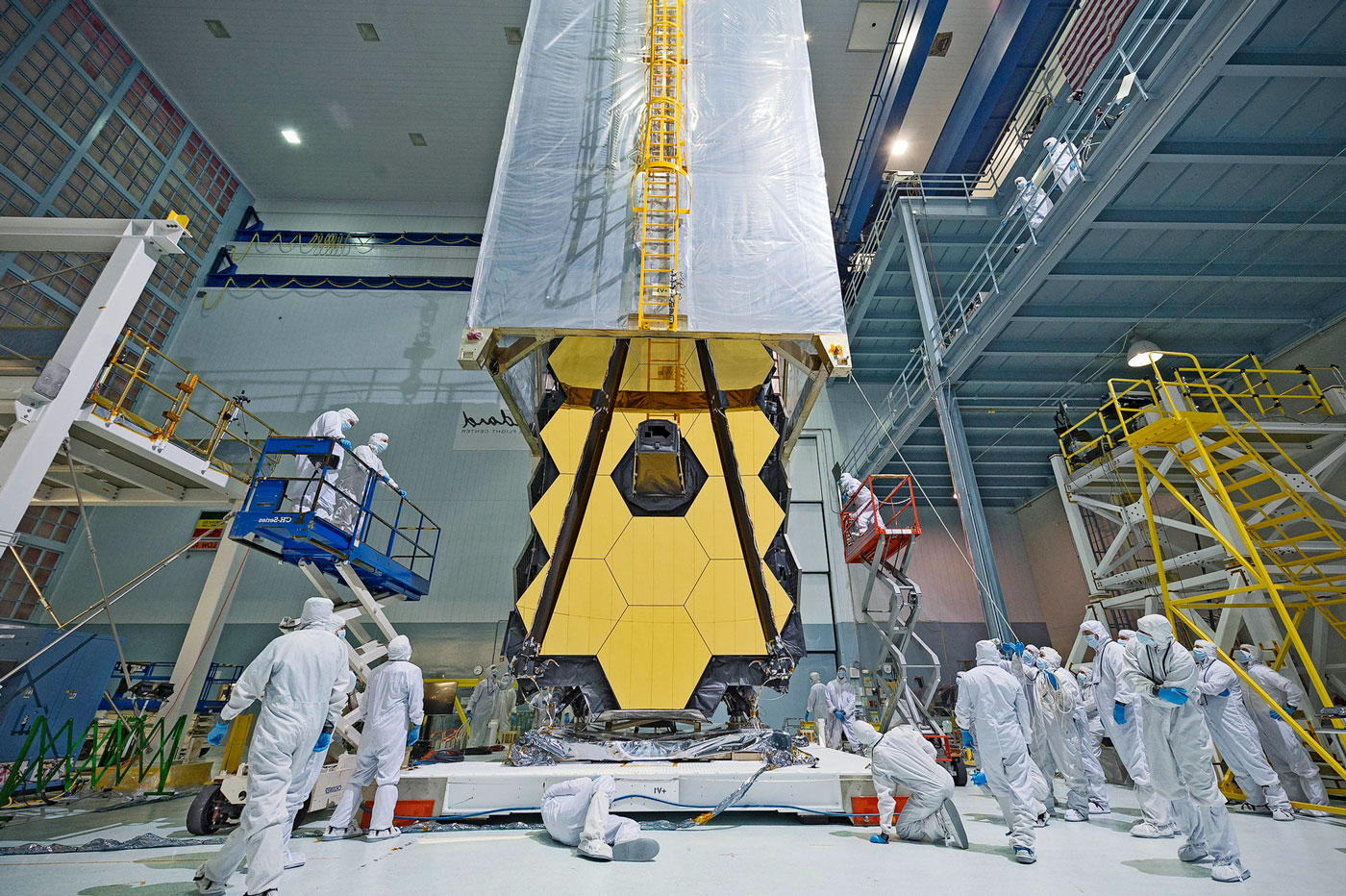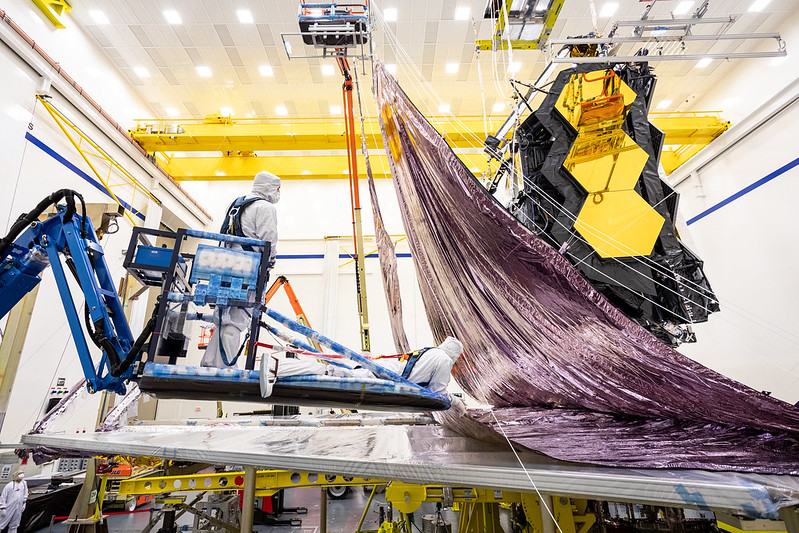The James Webb Telescope: Insane Engineering

The James Webb telescope is the most powerful space telescope to date. It’s a large, infrared telescope that will be able to collect data from the earliest time in the history of the Universe. James Webb Telescope is set to launch in December 2021 and will revolutionize our understanding of space.
NASA has been working on this project for a long time. It will be able to sense infrared light which means it can see things that telescopes today can’t see which includes stars and galaxies forming after the Big Bang.
Table of Contents
ToggleThe Mirrors of the James Webb Space Telescope
The telescope has been designed with an 18-segmented primary mirror that is roughly 6.5 meters in diameter. This mirror will be segmented into 18 individual hexagons, which will be made up of beryllium mirrors and have a weight of 39 kg each. The secondary mirror on the James Webb Telescope is 2.4 meters in diameter and it will be made up of a lightweight 5-layer material called Kapton.
These segments are coated with gold and arranged so that they can be folded up for storage during launch. They will unfold whilst in orbit around the earth, allowing the telescope to work effectively. The mirrors will also help focus light by using a process called “grazing incidence.” The imager mirror system is designed to use infrared technology, which has not been used before in space telescopes due both to technological limitations and cost restrictions from NASA’s budgeting process for this project.
The mirrors of the James Webb Space Telescope are made from beryllium, which can be polished to form a thin reflective surface with less weight than other materials. This means that the JWST will not need as powerful a rocket as other space telescopes, since less fuel will be needed for lift off.
How the James Webb Space Telescope Works
The James Webb Space telescope will be placed in orbit about a million miles from Earth, roughly four times the distance of our planet from the Moon. James Webb Space telescope is the successor to the Hubble Space Telescope. It has a 6.5 meter (21 ft) primary mirror and will be placed in orbit about a million miles from Earth, roughly four times the distance of our planet from the Moon. The telescope will be able to observe phenomena that are impossible to see with today’s technology, such as star formation and close exoplanets.
Highly technological and precise instrument. It is one of the most incredible achievements in space exploration. The James Webb Space Telescope will be the successor of the Hubble telescope and will be able to view galaxies from much farther distances. It is designed to function for a longer period than its predecessor. The telescope will have a mirror that is about six times bigger than that of Hubble, which means that it can detect much fainter objects.
Is the James Webb Space Telescope Really Worth It?
The James Webb Space Telescope is the most expensive space telescope ever built. As of today, it is estimated at $8.7 billion, which is more than three times the original estimate of $5.4 billion in 1995. The James Webb Space Telescope was originally conceived in 1996 to replace the Hubble Space Telescope, but its development has been delayed by years due to budget overruns and technical difficulties.
It has been reported that NASA’s budget for astrophysics has decreased dramatically over recent years while funding for other projects increased substantially. The question arises whether it is worth it to invest so much money into a telescope that will be outgrown within a few years by new discoveries in astrophysics.
What is The Timeline for The James Webb Space Telescope?
The James Webb Space Telescope (JWST) is a large and complex project, which can be seen in the timeline we have provided below.

Source: @nasa
- In 1996, a new space telescope was announced.
- 2000: NASA’s NEXUS Spacecraft was cancelled
- September 2002: NGST renamed James Webb Space Telescope
- On September 11th, 2003, $824.8 million in contracts were awarded to TRW
- Almost all tech developments from January 2007 have been reviewed.
- April 2010: technical part of Mission Critical Design Review (MCDR) passes.
- July 2011: James Webb project threatened with cancellation.
- November 2011: JWST survives cancellation attempt.
- 2012: MIRI instrument hand-off.
- March 2013: FGS/NIRISS installed in ISIM.
- July 4, 2013: MIRI installed in ISIM.
- March 2014: NIRCam installed in ISIM
- March 24–25, 2014: NIRSpec integrated into ISIM.
- June 2014: first combined test of all four instruments including cryogenic testing in the Goddard Space Environment Simulator.
- 2014: peak U.S. funding hit with $650 million this year.
- February 2015: hexagonal segments of the primary mirror completed.
- December 2015: contract for JWST’s launcher signed with a launch date of October 2018.
- March 2016: cryogenic testing of instruments and mirrors completed.
- March 3, 2016: secondary mirror installed on OTE.
- March 2016: Aft Optics Subsystem installed on OTE.
- November 2016: JWST construction completed (still needed testing, etc.)
- January 2017: JWST is fine after experiencing an anomaly during vibration testing in Dec 2016.
- March 27, 2018: JWST launch delayed to at least May 2020 as issues with the spacecraft element require further testing.
- June 27, 2018: JWST launch postponed to March 30, 2021 based on recommendations by an Independent Review Board.
- July 16, 2020: JWST launch postponed to October 31, 2021 due to impacts from the coronavirus (COVID-19) pandemic, as well as technical challenges.
- June 1, 2021: JWST launch postponed to no earlier than November 2021 due to concerns regarding the readiness of the Ariane 5 launch vehicle and launch site.
- September 8, 2021: JWST launch postponed to December 18, 2021.
- November 22, 2021: JWST launch delayed to no earlier than December 22, 2021, to allow additional testing after experiencing vibrations due to an unplanned clamp release.
- December 21, 2021: JSST launch delayed to no earlier than 12:20pm on December 25, 2021, due to adverse weather conditions at the launch site.
Conclusion:
Space exploration has always been a dream for humans, and we’ve achieved the impossible. But we always want to push boundaries and explore farther and deeper – and the James Webb Space Telescope is the next big thing in space exploration.
This telescope will be able to see things that no other telescope can see before it, like exoplanets. It will be able to study light from galaxies that are too far away to reach by any other means, like gravitational waves. And it’ll be doing all of this from a much closer distance than any other telescope has done before it – making it a very promising piece of modern technology in space exploration.
EngineeringNASASatelliteSpace NewsTelescope
Aroound
aroound.com is a blog website with the aim to provide you the latest information around world. It helps you find the most relevant blogs on any topic.